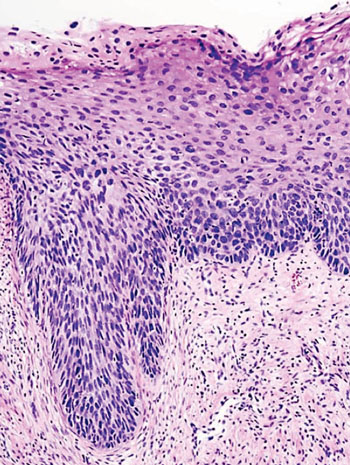Persistent HPV Infection Raises Risk of Anogenital Cancers
By LabMedica International staff writers
Posted on 21 Jul 2016
Women with a history of severe cervical intraepithelial neoplasia, a precancerous condition of the cervix that arises from infection with the human papillomavirus, have a long-term increased risk of developing anal, vulvar, and vaginal cancer.Posted on 21 Jul 2016
High-risk human papillomavirus (HPV) is essential for developing high-grade cervical intraepithelial neoplasia (CIN2 and CIN3) and has also been associated with noncervical anogenital cancers. However, limited knowledge exists about the long-term risk for anal, vulvar, and vaginal cancer following CIN2 or CIN3 diagnosis.

Image: A histopathology of high-grade cervical intraepithelial neoplasia CIN 3. There is severe dysplasia that involves more than 2/3 of the epithelium, and may involve the full thickness. This lesion may sometimes also be referred to as cervical carcinoma in situ (Photo courtesy of Dr. Sean Kavanagh).
Scientists at the Danish Cancer Society Research Center (Copenhagen, Denmark) identified women through Denmark's system of personal identification numbers, which they linked to the Danish Cancer Registry and the Pathology Data Bank to obtain information on verified cases of CIN2 and CIN3, as well as cancer diagnoses. In order to ascertain whether CIN3 was also associated with anal, vulvar, and vaginal cancer, they studied 2.8 million women who were recorded as living in Denmark between 1978 and 2012, following some women for up to 34 years.
Of these women, about 104,000 had CIN3 and about 52,000 had CIN2; the rest of them had no history of these conditions. The study found that when compared with women with no history of the disease, women with CIN3 were 4.2 times more likely to develop anal cancer, four times more likely to develop vulvar cancer, and 17 times more likely to develop vaginal cancer. Women with CIN2 were 2.9 times more likely to develop anal cancer, 2.5 times more likely to develop vulvar cancer, and 8.1 times more likely to develop vaginal cancer than women with no history of the disease.
Susanne K Kjaer, MD, the senior author of study, said, “That while the connection between HPV and cervical cancer is well known, the results of this study add anogenital cancers to the list of potential long-range consequences of HPV infection and could add to support for vaccination against the virus. The HPV vaccine is prophylactic, and if we can prevent HPV infection from occurring in the first place, we can prevent some of these conditions that result from persistent infection. The risk of anal, vulvar, or vaginal cancer was highest in the first year after diagnosis with CIN3. However, the increased risk persisted even when excluding cases that were diagnosed in the first year.” The study was published on June 29, 2016, in the journal Cancer Epidemiology, Biomarkers and Prevention.
Related Links:
Danish Cancer Society Research Center














